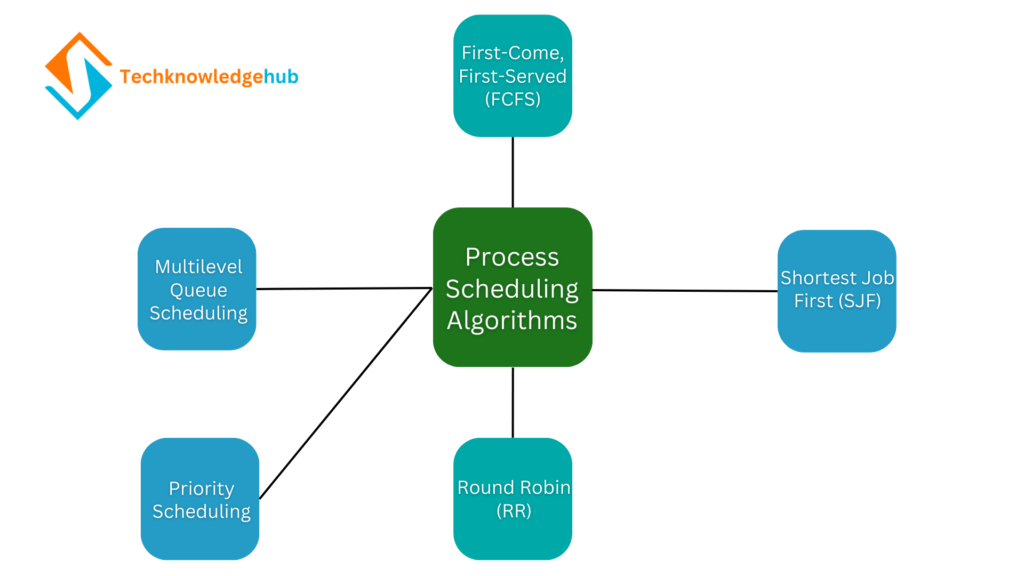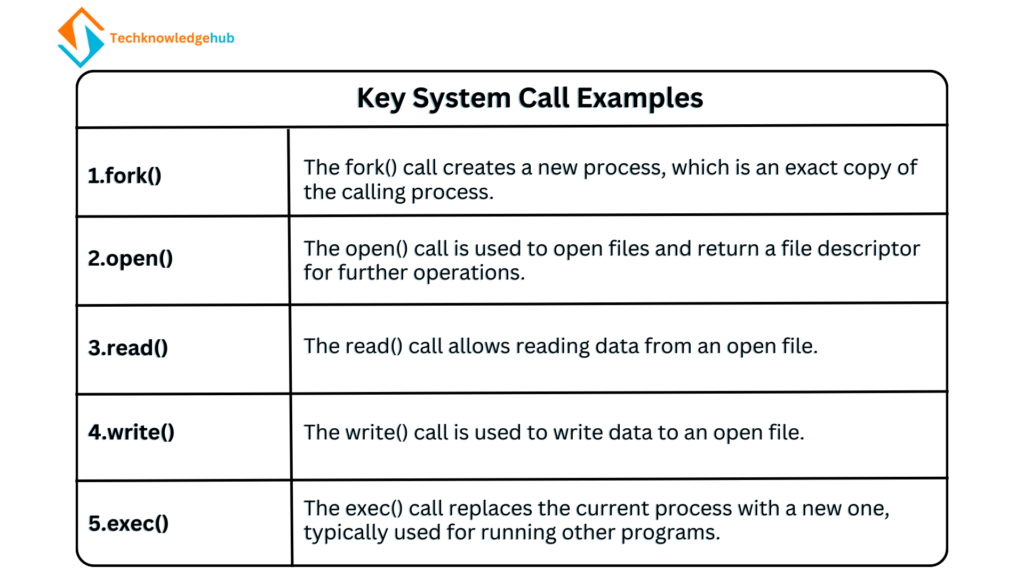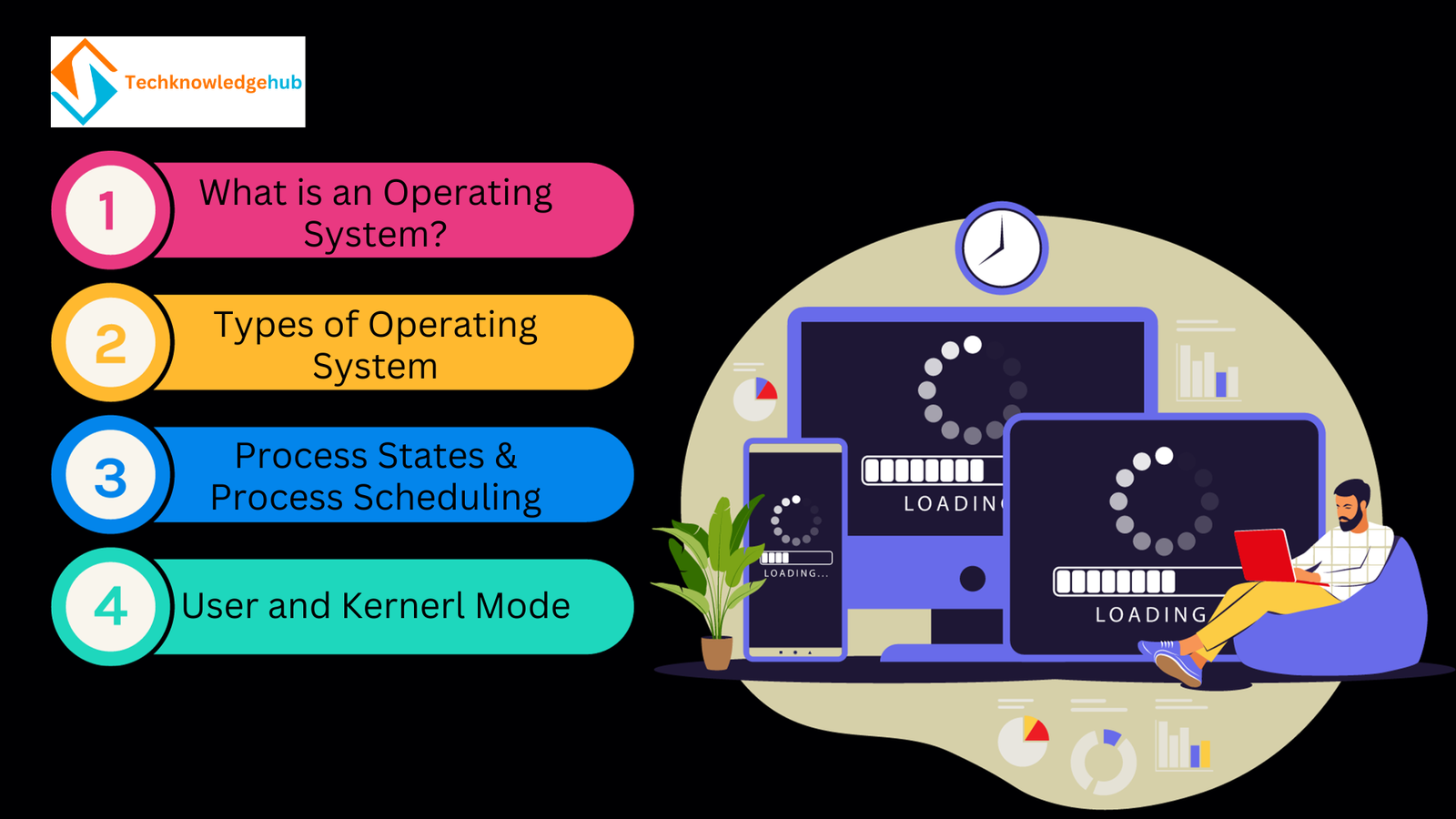Introduction
An operating system (OS) is the backbone of any computing device, be it a personal computer, smartphone, or even a microwave oven with smart features. While we often take it for granted, the operating system plays a pivotal role in enabling our interaction with the hardware and software of these devices. In this article, we will delve into the world of operating systems, exploring their importance, types, process states, system calls and their significance in our ever-evolving technological landscape.
Table of Contents
Understanding the Basics of an Operating System
What is an Operating System?
At its core, an operating system is a software that manages and controls the hardware components of a computer or any computing device. It serves as an intermediary between the user and the hardware, ensuring that the user’s instructions are executed efficiently. The OS handles a myriad of tasks, such as managing memory, facilitating communication between software applications and hardware components, and providing a user-friendly interface.
The Importance of an OS
Imagine a computer without an operating system. It would be a complex machine that can do very little without the right software. The operating system bridges this gap, making it possible for users to interact with the computer effortlessly. It manages resources, allocates memory, and handles peripheral devices like keyboards, monitors, and printers. This seamless interaction between the user and the machine is made possible by the presence of an operating system.
Types of Operating Systems:
- Real-time Operating Systems
- Single-User Operating Systems
- Multi-User Operating Systems
- Distributed Operating Systems
- Network Operating Systems
- Mobile Operating Systems
- Embedded Operating Systems
- Server Operating Systems
1. Real-time Operating Systems
Real-time operating systems are designed to execute tasks with precise timing, ensuring timely responses to critical processes.
Common Uses:
- Aerospace and aviation control systems.
- Industrial automation and robotics.
Examples:
- VxWorks: Widely used in real-time systems.
- QNX: Commonly found in automotive and medical devices.
2. Single-User Operating Systems
Single-user operating systems are designed for personal computing, allowing one user to interact with the computer at a time.
Common Uses:
- Personal computers for daily tasks and entertainment.
Examples:
- Microsoft Windows: Ubiquitous on personal computers.
- macOS: Exclusive to Apple’s desktop and laptop devices.
3. Multi-User Operating Systems
Multi-user operating systems enable multiple users to access a computer or server simultaneously while preserving data security.
Common Uses:
- Business environments, servers, and shared resources.
Examples:
- Linux: Widely used in server environments.
- Unix: Employed in academic and research institutions.
4. Distributed Operating Systems
Distributed operating systems manage interconnected computers, providing a unified environment for distributed computing.
Common Uses:
- Clusters of computers working together on complex tasks.
Examples:
- Amoeba: Supports distributed computing.
- Google’s Fuchsia: Designed for diverse devices.
5. Network Operating Systems
Network operating systems are tailored for managing network functionality and facilitating communication and resource sharing among multiple computers.
Common Uses:
- Network administration and file sharing.
Examples:
- Windows Server: Used in businesses for network operations.
- Novell NetWare: Designed for network management.
6. Mobile Operating Systems
Mobile operating systems power smartphones and tablets, offering touch-based interfaces and access to a variety of applications.
Common Uses:
- Smartphones and tablets.
Examples:
- Android: Used in the majority of smartphones and tablets.
- iOS: Exclusive to Apple’s mobile devices.
7. Embedded Operating Systems
Embedded operating systems are designed for specific functions in embedded devices like microwaves, thermostats, and automotive systems.
Common Uses:
- IoT devices and embedded systems.
Examples:
- FreeRTOS: Commonly used in IoT devices.
- VxWorks (for embedded): Applied in industrial controllers.
8. Server Operating Systems
Server operating systems are optimized for hosting websites, managing data, and supporting network operations in enterprise environments.
Common Uses:
- Hosting websites and managing data in business environments.
Examples:
- Windows Server: Widely used in businesses for hosting websites and data management.
- Red Hat Enterprise Linux: A popular choice for web servers.
Understanding the definitions, common uses, and examples of these operating systems is crucial for choosing the right one to meet specific needs. Whether for personal use, business operations, or specialized applications, selecting the appropriate OS significantly impacts the efficiency and functionality of your computing environment.
What is a Process State in OS?
A process in the context of an operating system can be considered as an individual program that is in execution. The process state represents where a particular program is in its lifecycle, and it can be categorized into several distinct states. Each state corresponds to a specific stage in the execution of the process.

Importance of Managing Process States
Efficiently managing process states is crucial for several reasons. Firstly, it allows the operating system to allocate system resources optimally. Secondly, it helps in preventing processes from interfering with each other, ensuring the system’s stability. Finally, it enables the operating system to provide a responsive and seamless user experience.

A Real-Life Analogy
Imagine an airport where different flights represent processes. Understanding the state of each flight (e.g., boarding, take-off, landing) is crucial for efficient airport operations. Similarly, in an operating system, knowing the process state is vital for managing system resources and ensuring smooth execution.
How Modern OS Manages Process States
Modern operating systems employ advanced techniques and algorithms to manage process states effectively. They utilize multi-core processors and complex scheduling mechanisms to juggle numerous processes simultaneously.
What is Process Scheduling?
Process scheduling is the art and science of managing multiple processes in a computer system. It involves selecting the next process to be executed by the CPU from the pool of ready processes. An efficient process scheduling algorithm can significantly impact the system’s performance and user experience.

Different Process Scheduling Algorithms
First-Come, First-Served (FCFS)
FCFS is one of the simplest scheduling algorithms. It prioritizes processes in the order they arrive in the ready queue. While it is easy to understand and implement, FCFS can lead to the “convoy effect,” where a long process can hold up shorter processes behind it.
Shortest Job First (SJF)
The SJF algorithm selects the process with the shortest execution time next. This minimizes waiting time and improves system throughput. However, predicting the exact execution time of processes can be challenging.
Round Robin (RR)
Round Robin is a time-sharing algorithm that allocates each process a fixed time slice. Once a process’s time slice is up, it moves to the back of the queue. This ensures fair CPU access for all processes, but it may lead to suboptimal performance for long-running processes.
Priority Scheduling
Priority scheduling assigns a priority to each process. The process with the highest priority is executed first. It allows for more control over important processes but can lead to starvation if lower-priority processes are consistently neglected.
Multilevel Queue Scheduling
Multilevel queue scheduling categorizes processes into multiple queues, each with its own scheduling algorithm. For example, interactive processes may be in one queue, while batch processes are in another. This approach provides flexibility but requires sophisticated management.
User Mode and Kernel Mode
In the realm of operating systems, the concepts of User Mode and Kernel Mode play a crucial role in maintaining system stability, security, and efficient resource utilization. These two distinct modes govern how software interacts with hardware and the privileges assigned to various processes. This article explores User Mode and Kernel Mode, delving into their definitions, functions, and their significance in the world of operating systems.
1. User Mode
User Mode, also known as User Space, is a mode of operation in which software applications run on a computer system. In User Mode, processes are restricted in terms of the system resources and hardware instructions they can access. It is designed for the execution of user-level applications, ensuring that they do not interfere with critical system functions.
Role and Limitations
User Mode serves as a protective boundary that isolates user-level applications from the core of the operating system. Processes running in User Mode have limited access to the hardware, preventing them from making direct changes to system settings or memory. This restriction is in place to maintain system stability and security.
User Mode Applications
User Mode is where everyday applications like web browsers, word processors, and games operate. These applications run in a safe, isolated environment where they cannot disrupt the core operations of the operating system. User Mode is characterized by its simplicity, accessibility, and the ease with which applications can be installed and executed.
2. Kernel Mode
Kernel Mode, also known as Supervisor Mode or Privileged Mode, is the heart of the operating system. It is where the core kernel, responsible for managing hardware, system services, and critical operations, resides. In Kernel Mode, processes have elevated privileges and direct access to system resources.
Privileges and Responsibilities
Kernel Mode processes are granted extensive privileges to perform tasks such as memory management, hardware control, and handling system calls. The kernel operates at the highest level of system authority, allowing it to make crucial decisions regarding resource allocation and process execution.
Kernel Mode Operations
In Kernel Mode, the kernel can execute instructions that are not accessible in User Mode. These operations include managing memory allocation, controlling hardware components, and responding to hardware interrupts. The kernel is responsible for maintaining the system’s integrity, security, and responsiveness.
Real-World Analogy
Comparing User Mode and Kernel Mode to Real-Life Scenarios
An analogy to understand User Mode and Kernel Mode is to envision User Mode as a guest in a hotel room. The guest can use amenities provided by the hotel but cannot access sensitive areas. The hotel staff, representing the kernel, manages and controls critical operations, ensuring the guest’s safety and overall experience.
Introduction to System Calls
System calls are the bridge between user-level applications and the operating system’s kernel. They provide a controlled entry point into the kernel, allowing processes to request services from the operating system. These services encompass a wide range of functionalities, from opening and reading files to managing processes and handling devices.
The Purpose of System Calls
System calls are essential for several reasons:
- Abstraction: They hide the complex operations of the kernel from user programs, providing a simplified interface.
- Protection: System calls ensure that one process cannot interfere with the memory or resources of another process.
- Resource Management: They manage and allocate resources efficiently, preventing resource conflicts.
- Security: System calls maintain the security and integrity of the operating system.
How System Calls Work
System calls are typically invoked by programs through a high-level Application Programming Interface (API). These calls are handled by the operating system, which switches the processor to kernel mode for secure execution. After completing the requested task, control is returned to the user program.
Types of System Calls
System calls are categorized into four main types:

Key System Call Examples
Let’s explore some common system calls:

Implementing System Calls
System calls are implemented by writing functions in the operating system kernel, which are then invoked through the API provided to user programs.
System Calls and User Programs
User programs utilize system calls to access kernel services. These calls are included in the program code, which allows them to interact with the operating system effectively.
Interaction with the Kernel
When a system call is made, the processor switches to kernel mode, giving it the necessary privileges to execute the requested operation. This ensures the security and integrity of the system.
FAQs
- What are the different types of operating systems?
- Operating systems can be categorized into several types, including Windows, macOS, Linux, Unix, and mobile operating systems like Android and iOS.
- What is the role of an operating system in managing processes?
- Operating systems manage processes by scheduling, coordinating, and allocating resources to ensure efficient execution of tasks.
- What are the typical process states in an operating system?
- Process states include “Ready,” “Running,” “Blocked,” “Terminated,” and “New” states, each representing a different stage of a process’s lifecycle.
- What is “User Mode” in an operating system?
- User mode is a restricted mode in which user-level applications run, with limited access to system resources to ensure security and stability.
- What is “Kernel Mode” in an operating system?
- Kernel mode, also known as supervisor mode, is the privileged mode in which the operating system’s kernel runs. It has full access to system resources and hardware.
- How does a system call transition from user mode to kernel mode?
- When a user-level program makes a system call, it triggers a context switch, transitioning the CPU from user mode to kernel mode, allowing the system call to execute with the necessary privileges.
- What is the purpose of system calls in an operating system?
- System calls provide a controlled interface for user-level applications to request services from the operating system, such as file operations, process management, and device access.
- Can system calls differ between different operating systems?
- Yes, system calls can vary between different operating systems, and developers need to use the specific set of calls supported by the target operating system.
- What happens when a system call encounters an error?
- When a system call encounters an error, it typically returns an error code or value, allowing the program to handle the error and take appropriate action.
- How do system calls impact the performance of an operating system?
- System calls have a significant impact on an operating system’s performance, as they involve switching between user mode and kernel mode, which can affect efficiency and responsiveness.
- Are there any security considerations when working with system calls?
- Security is a critical concern when working with system calls. Unauthorized or malicious use of system calls can lead to security vulnerabilities and system breaches.
- How do system calls differ from library functions in programming?
- System calls interact directly with the operating system kernel, while library functions are higher-level abstractions built on top of system calls, providing more user-friendly interfaces.
- What are some real-world examples of system calls in everyday computing?
- Real-world applications of system calls include file operations like reading and writing files, network communication, process management, and hardware device access.



